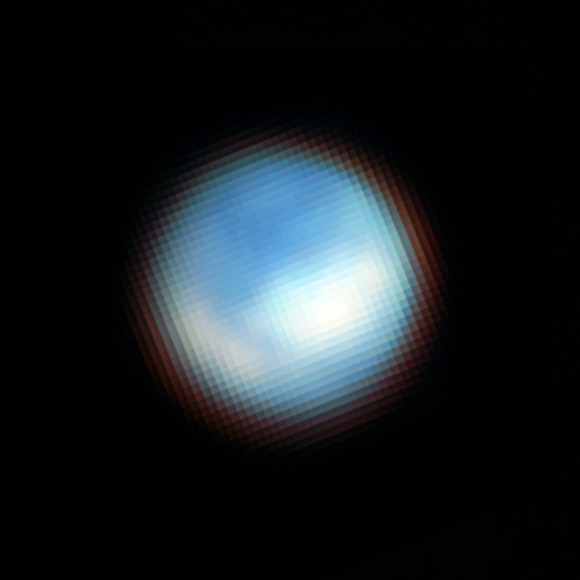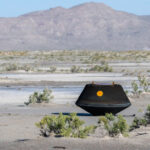Jupiter’s icy moon Europa has an ocean beneath a crust of water ice. Solid carbon dioxide has previously been observed on the surface, but the source was unknown. Two teams analyzed infrared spectroscopic data of Europa from the NASA/ESA/CSA James Webb Space Telescope to investigate the source of carbon dioxide.
Webb identified carbon dioxide on the icy surface of Europa that likely originated in the moon’s subsurface ocean. Image credit: Geronimo Villanueva, NASA’s Goddard Space Flight Center / Samantha Trumbo, Cornell University / NASA / ESA / CSA / Alyssa Pagan, STScI.
Beneath a crust of solid water ice, Europa is thought to have a subsurface ocean of salty liquid water.
Because of this, Europa is a prime target in the search for life elsewhere in the Solar System.
Assessing this deep ocean’s potential habitability depends on its chemistry, including the abundance of biologically essential elements like carbon.
Previous research has identified the presence of carbon dioxide ice on Europa’s surface, but it has not been possible to establish whether carbon dioxide originated from the subsurface ocean, was delivered to the moon’s surface by meteorite impacts, or was produced on the surface through interactions with Jupiter’s magnetosphere.
Determining the source of carbon dioxide could constrain the chemistry of Europa’s internal ocean.
“On Earth, life likes chemical diversity — the more diversity, the better,” said Dr. Geronimo Villanueva, a researcher at NASA’s Goddard Space Flight Center.
“We’re carbon-based life. Understanding the chemistry of Europa’s ocean will help us determine whether it’s hostile to life as we know it, or if it might be a good place for life.”
“We now think that we have observational evidence that the carbon we see on Europa’s surface came from the ocean. That’s not a trivial thing. Carbon is a biologically essential element,” said Dr. Samantha Trumbo, a researcher at Cornell University.
In their two studies, the authors analyzed near-infrared spectroscopy of carbon dioxide on Europa’s surface, obtained with Webb’s Near-Infrared Spectrograph (NIRSpec).
In the first study, Dr. Trumbo and her colleague, Caltech researcher Michael Brown, used the Webb data to map the distribution of carbon dioxide on Europa and found the highest abundance of carbon dioxide is located in Tara Regio, a 1,800-km2 region dominated by chaos terrain, geologically disrupted resurfaced materials.
According to the team, the amount of carbon dioxide identified within this recently resurfaced region — some of the youngest terrain on Europa’s surface — indicates that it was derived from an internal source of carbon.
This implies that carbon dioxide formed within Europa’s subsurface ocean and was brought to the surface on a geologically recent timescale.
However, the formation of carbon dioxide on the surface from ocean-derived organics or carbonates cannot be entirely ruled out. In either interpretation, the subsurface ocean contains carbon.
“Previous observations from the NASA/ESA Hubble Space Telescope show evidence for ocean-derived salt in Tara Regio,” Dr. Trumbo said.
“Now we’re seeing that carbon dioxide is heavily concentrated there as well. We think this implies that the carbon probably has its ultimate origin in the internal ocean.”
In the second study, Dr. Villanueva and colleagues found that carbon dioxide on Europa’s surface is mixed with other compounds.
They also found that carbon dioxide is concentrated in Tara Regio and interpreted that as demonstrating that the carbon on the moon’s surface was sourced from within.
The scientists measured the ice’s 12C/13C isotopic ratio, but could not distinguish between an abiotic or biogenic source.
Moreover, they searched for plumes of volatile material breaching moon’s icy crust.
Although previous studies have reported evidence of these features, the authors did not detect any plume activity during the Webb observations.
They argue that plume activity on Europa could be infrequent, or sometimes does not contain the volatile gasses they included in their search.
“Scientists are debating how much Europa’s ocean connects to its surface. I think that question has been a big driver of Europa exploration,” Dr. Villanueva said.
“This suggests that we may be able to learn some basic things about the ocean’s composition even before we drill through the ice to get the full picture.”
_____
Samantha K. Trumbo & Michael E. Brown. 2023. The distribution of CO2 on Europa indicates an internal source of carbon. Science 381; doi: 10.1126/science.adg4155
G.L. Villanueva et al. 2023. Endogenous CO2 ice mixture on the surface of Europa and no detection of plume activity. Science 381; doi: 10.1126/science.adg4270




